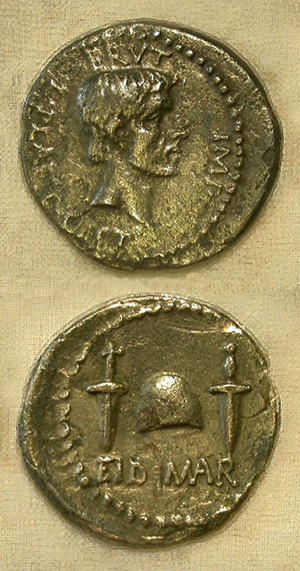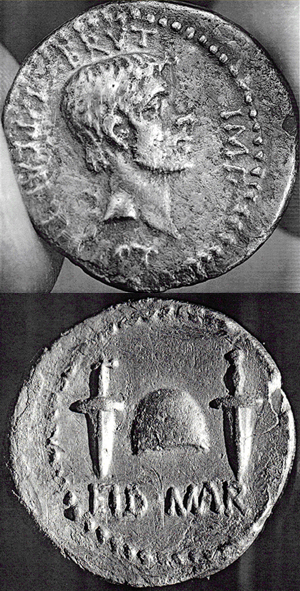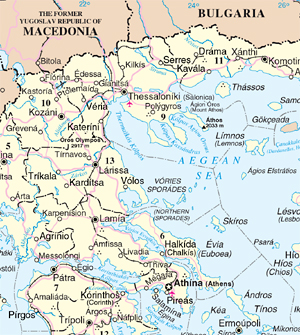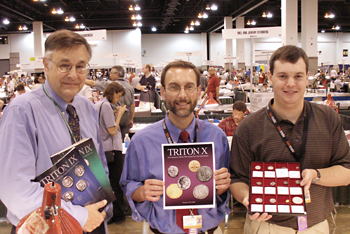Even seasoned dealers can get stung
By Leon Worden
November 2006
|
| N |
Flying under the news radar is one type of illegally trafficked antiquity that outnumbers all the plundered Greek vessels and Roman statues combined: ancient coins.
You don't hear about them because they're rarely identified and returned. They aren't like an unmistakable marble head of Augustus. Most coins aren't unique. The same design was replicated hundreds and even thousands of times.
Smugglers don't generally record their transactions or file pedigree charts with auction houses — and neither do the legitimate owners of most of the world's ancient coins — so it's difficult to know whether one was lawfully bought and sold or illegally excavated and illicitly ushered out of its country of origin. Unless the thieves are caught red-handed.
In June, the Greek government recovered an example of one of the most important and interesting coins of the ancient world: a silver denarius issued by Marcus Brutus in 42 B.C. celebrating his assassination of Julius Caesar on March 15, 44 B.C. — the Ides of March.
The obverse bears a portrait of Brutus with the inscription BRVT(us) IMP(erator) L(ucius) PLAET(orius) CEST(ianus). Lucius Plaetorius Cestianus was the name of the coiner who managed the mobile mint Brutus used while in Macedonia.
The reverse shows a liberty cap, the ancient symbol of freedom, flanked by two daggers above the inscription EID(ibus) MAR(tiis). Eidibus (ides) is Latin for an equal division, or middle. Martiis is the month of March.
The coin showed up in June 2005 at the London office of Classical Numismatic Group, one of the largest and most reputable firms in the ancient coin business.
Why the Greek government wanted it had little to do with its rarity. Somewhere between 58 and 80 are known to exist, including two in gold. Nor was it because of its state of preservation. Far from the finest-known specimen, it is off-center and badly scarred.
Rather, evidence suggests that the Greeks went after it because of the people involved. The man who sold it to CNG turned out to be a Greek national with a criminal record for trafficking in stolen antiquities, and the transaction was arranged by a Munich coin dealer who once worked for a notorious European trafficker, a member of a Munich cartel whose looted treasures found their way to studios, museums and auction houses around the world. A CNG executive said his company had no idea.
The experience gives new meaning to a pair of popular phrases: "Beware the Ides of March" and, more importantly, "Know your seller."
Two things must be made clear at this point:
1. Nobody has suggested that CNG knowingly did anything wrong. The company went by the book. As it does in the normal course of business, when it purchased the coin it required a written declaration of the seller's clear title to the coin. When his ownership later came into question, CNG held onto the coin for 11 months instead of selling it, which it could have done under British law. When the Greek claim for the coin finally was upheld in a British court, CNG gave it back without protest.
2. As of this writing in early September, neither British nor Greek officials (nor CNG) are disclosing the identity of the seller or the coin dealer who accompanied him to CNG's London office. Nor are they providing details of the seller's background or his apprehension following the sale of the coin.
|
"I didn't want to make a trip to Munich just for one coin, so I invited him to come to London," said McFadden, CNG's senior director in Europe.
A veteran ancient-coin dealer, McFadden got his start at Numismatic Fine Arts in Beverly Hills, California. He went to Harvard Law School, passed the bar exam in 1986, and practiced law in Los Angeles before joining CNG in 1990. The company was founded in 1986 in Lancaster, Pennsylvania, by Victor England Jr., its other senior director. Today, it maintains offices in Lancaster and London.
"There was nothing apparently unusual about this transaction," McFadden remembered. "This happens all the time. We're coin dealers. People phone us with something to sell."
The man from Munich "knows who we are and knows we would be buyers for a coin like that, and we would have money available to pay for it," he said.
The other man was unknown to McFadden, although he looked vaguely familiar, as if McFadden had seen him somewhere before. He spoke no English.
McFadden agreed to a price of 18,000 euros, or roughly $23,000.
"That is the top wholesale value," he said. "The retail price is something like $30,000, which is what we probably would have asked for it."
McFadden went to his bank and withdrew the 18,000 euros. He completed the transaction in euros instead of British pounds because the dealer was from Munich and the other man evidently was from Greece. It was a simple matter to withdraw the cash; there is no U.K. equivalent to the documentation required for a large cash transaction in the U.S.
Back at the CNG office, "I did all the normal paperwork," McFadden said. "I did a purchase invoice. I had the name and address of the dealer who was the seller of the coin. He signed off on it, guaranteed that the coin was authentic and that he had good title to it. It was just normal procedure.
"The person I was dealing with was the [coin] dealer," he said. "The other chap was there for the ride, as far as I was aware."
McFadden had no idea anything was wrong until shortly after the two men tried to leave the country through Stansted Airport, London's No. 3 airport after Heathrow and Gatwick, primarily serving continental European destinations. Customs agents wanted to know what the men were doing with 18,000 euros they didn't have when they arrived.
"Customs phoned me and I said, 'Yes, they sold a coin to me. I just paid them for it,'" McFadden said.
He sent a copy of the purchase invoice to British Customs, which decided something was amiss and seized the cash under the U.K.'s Proceeds of Crime Act. It is not known what tipped them off.
The case was assigned to Customs Investigator John Woodthorpe, who apparently placed a call to Victoria Solomonidis, the cultural attaché at the Greek embassy in London, asking her if the Greek government wanted to file a claim for the coin. It did.
Woodthorpe and Solomonidis declined to comment for this story, pending the outcome of a hearing scheduled for Sept. 12 to determine whether CNG would get its money back.
While the presumption is that CNG received stolen or illicitly trafficked property, McFadden sees it differently.
"If we were defrauded by representation that they had the right to sell this coin when they actually didn't, then we're the victims of that crime. That is the basis under which we will ask for the return of the cash," he said.
Chris Rudd, a prominent Celtic coin dealer in Norfolk, England, was highly critical of CNG's treatment.
"It seems scandalous to me," he said, "that the world's foremost ancient coin company, an organization of international repute and integrity, can suffer a confiscation such as this without full and immediate compensation.
Were it not for CNG's customary honesty, patience and cooperation, the Greek government would never have been able to retrieve the coin by this questionable process."
According to a statement by Greek Culture Minister Giorgos Voulgarakis, on Apr. 18, 2006 Greece hired a British attorney, Alan Bercow of Stephenson Harwood, to pursue the government's claim in the British High Court.
Voulgarakis said Bercow and Solomonidis requested the return of the coin under European Union Directive 93/7, which regulates the return of objects of cultural significance that have been involved in illicit trade and export.
"These laws have been in force for over 10 years, but this is the first time they have been used in Britain," Bercow told The Timesof London.
It was, however, the fifth ancient object returned from Britain to Greece since May 2004, Voulgarakis said. Voulgarakis has had less success in recovering scores of Greek marble sculptures in the British Museum that were removed from the Parthenon in Athens in the early 1800s by Thomas Bruce, Lord Elgin.
According to the Hellenic Ministry of Culture, only four EID-MAR coins have an established Greek origin: two that were found near the northern Greek city of Florina and now reside in the Archaeological Museum of Pella (Greece); and two others, one silver and one gold, in private European collections.
While Voulgarakis placed the total number of EID-MAR coins at 58, based on numismatic texts published in the 1970s and 1980s, McFadden believes the figure is higher.
"I would say there are pieces that the authors missed or that have come to light since then," he said. "My guess is, there are probably around 80 known pieces."
How the Greek government determined — and proved to the British High Court — that this one emanated from Macedonia is unclear.
Asked that question at the press conference following the coin's recovery, Voulgarakis said simply, "Look, it would have been handled differently in Greece if it were not certain that it emanated from us." (His words are translated from the original Greek.) He indicated that the Munich dealer and his associate — both apparently Greek citizens — had been arrested, but he refused further comment.
In response to further inquiry from COINage, the Hellenic Ministry of Public Order (the justice department) said Sept. 9 that it "has no involvement, and consequently no information, regarding the case," suggesting that no criminal charges were filed.
Voulgarakis's press statement noted that 14 coins from the same period had been confiscated from smugglers who were trying to sell them in the northern Greek city of Thessaloniki. The coins had been excavated from the region of Dráama and Philippi in northern Greece, where Brutus set up camp.
|
"At some point, they were in the region of Dráma and they wanted to settle there and build a fixed facility to make the coins. It didn't happen."
It didn't happen because Brutus was dead.
Brutus never achieved the popularity he sought as a liberator when he and his dagger-wielding co-conspirators, by their account, freed Rome from Caesar's despotism in 44 B.C. Caesar was too beloved. Marc Antony, Caesar's close friend, rallied the public and accused Brutus and his allies of treason. Brutus and Cassius fled east to Athens.
Antony and Octavian, Caesar's official heir, sent their armies after Brutus and Cassius, driving them north into Macedonia. On the move, Brutus issued coins to pay his troops. Some of the coins that were made in the late summer and fall of 42 B.C. bore the EID MAR design — a reminder to his people that they had fought for the liberation of Rome.
Brutus met Octavian and Cassius met Antony on the battlefield at Philippi during the first week of October 42 B.C. Upon receiving false reports of Brutus's failure, Cassius committed suicide. Brutus regrouped and met his enemies again at Philippi on Oct. 23, 42 B.C. Octavian gained the upper hand; Brutus fled and, facing certain capture, fell on his sword.
So is an EID-MAR coin Roman or Greek?
"That's a very good question," McFadden said. "As Roman coins, they can circulate anywhere in the Roman Empire," not unlike a modern Greek euro coin that circulates throughout the European Union.
In fact, McFadden said, an EID-MAR coin was unearthed in Great Britain, which wasn't part of the Roman Empire when the coin was issued. Someone brought the coin home after traveling abroad.
Although details were not provided, it is unlikely that any of the 14 confiscated coins from the region of the battlefield was an EID-MAR coin. Nor was there any indication that the people involved in smuggling them had anything to do with the men who sold the EID-MAR coin to McFadden. The coins simply emanated from the same region.
All Greece would have to do under the European Union directive "is show by a preponderance of the evidence that a cultural object has been illegally exported," McFadden said. "If you want to argue against them, you have to come up with some contrary evidence."
|
So who was the mysterious second man who showed up in McFadden's office a year earlier? He was never introduced to McFadden as the seller.
"After the cash was seized," McFadden said, "his daughter kept phoning up, asking when her father could get his money back."
That provided a clue that the man was indeed the seller.
"That's something that happened after the fact," McFadden said. "Not only did I not know about it, but I couldn't have known about it." After all, it was the coin dealer who vouched for his ability to sell the coin.
"If someone brings a coin in to you and says they own it and they can sell it to you and they guarantee the authenticity — obviously I'm aware of any recent reports of theft, so if the coin had been reported stolen, I would have known about it — then there's nothing more one can do," McFadden said.
Longtime coin dealer Wayne Sayles, executive director of the Ancient Coin Collectors Guild, agreed.
"There is no tradition in the world market for the background-checking of sellers, nor is there any real reason for it," Sayles said. "There are pertinent and applicable laws in most countries that deal with import, theft, etc., and dealers do, in my experience, try diligently to follow those laws as they apply at the point of sale."
Sayles lamented that "we may have lost an opportunity to contest a claim that seems to be arguable on several grounds."
McFadden was notified that an investigation was under way and he set the coin aside. He was surprised that the officials didn't close the books right away. Instead, they discovered that the "second man" had been convicted in Greece of handling stolen antiquities and the Munich dealer turned out to have been in the employ of the late Nino Savoca.
Savoca's name comes up frequently in the annals of illicitly trafficked antiquities.
One high-profile case involved the recovery in 2004 of a life-size ivory head of Apollo, believed to have been carved in the fifth century B.C. by the great Greek sculptor Phidias. According to the McDonald Institute for Archaeological Research in Cambridge, England, the head was discovered in 1995 on a lakeshore north of Rome by Pietro Casasanta, a prominent tombarolo,or grave robber.
According to the institute, "He smuggled the head and fragments and the three statues [of Egyptian goddesses] out of Italy himself, and sold them to Nino Savoca, an Italian dealer based in Munich. They agreed [on] a fee of $10 million."
Savoca reportedly tried to sell the objects to two American museums, "neither of which was willing to risk buying such an obviously looted object." Savoca stopped payment after $450,000, and in 1998, he had a heart attack and died.
"During a raid on [Savoca's] premises, police discovered documentation that helped them close in on a number of important looted antiquities," the institute reported. Casasanta had gone to Germany to collect from Savoca's wife, only to be met by armed bodyguards, according to a report in The Wall Street Journal.
Vengeful and possibly fearing his time was up, Casasanta turned informant, telling the Italian Carabinieri Art Squad where to find the Apollo head. Savoca had sold it to Robin Symes, a London antiquities dealer who went to prison on unrelated charges. A fragment of a fresco stolen from a villa near Pompeii also was recovered from Symes' London studio, the archaeological institute reported.
Savoca was no stranger to the underside of life. On Jan. 31, 1996, he was the victim of the largest numismatic robbery in history. Masked men broke into his Munich villa, handcuffed his family, beat him and made off with more than 5,000 Greek and Roman coins, most of which are believed to have been smuggled out of Turkey in 1995.
How many thousands of Savoca's coins and other objects d'art were placed with unwitting and otherwise guiltless dealers over the last decade can never be known — probably all of them. And there are countless thousands more from other sources.
New sources are cropping up all the time. Legislation by Rep. Phil English, R-Pennsylvania, would have outlawed the private possession of antiquities plundered from war-torn Afghanistan — including coins. McFadden and other ancient-coin industry leaders lobbied hard against the bill; after all, how can one know whether a Greek or Roman coin that circulated throughout the empire was unearthed in Afghanistan?
The bill, HR 915, is in the inactive file. Julie Wanzco, the congressman's press secretary, said the bill was introduced in 2004 as a stopgap because at the time, Afghanistan was not a signatory to the 1970 United Nations convention on looted antiquities. President Hamid Karzai's government has now signed on, making HR 915 unnecessary, Wanzco said.
For Greek Culture Minister Giorgos Voulgarakis, the recovery of the latest EID-MAR coin probably was little more than a blip on the screen. As recently as Aug. 31, he recovered two more artifacts from the Getty Museum, which had obtained them from a smuggling ring that also sold at least 110 looted artifacts through auction giant Sotheby's, according to a judge in Rome. Ex-Getty Director Marion True awaits trial in Italy followed by an inquiry in Greece.
"The days when foreign museums and private collectors uncontrollably bought antiquities without any identity or passport have gone for good," Voulgarakis told reporters in Athens.
Voulgarakis hasn't given up hope of recovering the lost marble artworks. He was scheduled to fly to Germany in early September to recover a piece of a marble from the Parthenon at Heidelberg University.
The British Museum might want to beware.
©2006, MILLER MAGAZINES INC./LEON WORDEN. RIGHTS RESERVED.





